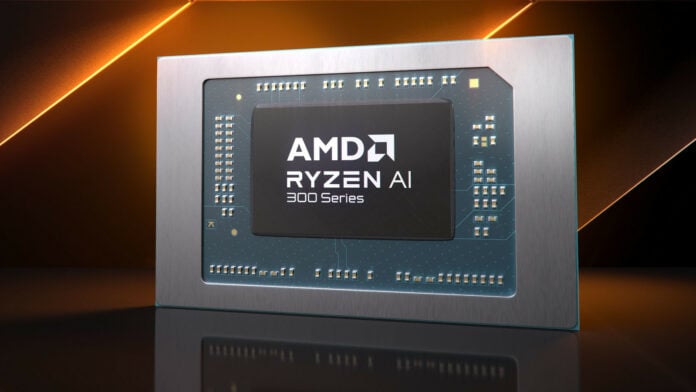Never judge a book by its cover, or a CPU by its branding in this case. AMD Ryzen AI 300 series certainly sounds like something only those interested in artificial intelligence should care about, but this couldn’t be further from the truth. In fact, this is the latest generation of mobile processors for laptops and handhelds, just announced at Computex 2024. While these chips look to be absolute trailblazers when it comes to handling AI workloads, they also offer substantial performance upgrades elsewhere that everyone can appreciate.
There’s little doubt that Ryzen AI 300 series processors will rank among the best CPUs you’ll find in mobile devices. Armed with Zen 5 cores, RDNA 3.5 graphics, and an XDNA 2 neural processing unit (NPU), AMD isn’t making it easy for Intel to spoil its plans for market dominance. Team Red has unveiled just two processors in the line-up: Ryzen AI 9 HX 370, and Ryzen AI 9 HX 365. However, the manufacturer has plenty to say about the capabilities of these chips, on their own merits and in comparison to competing options.
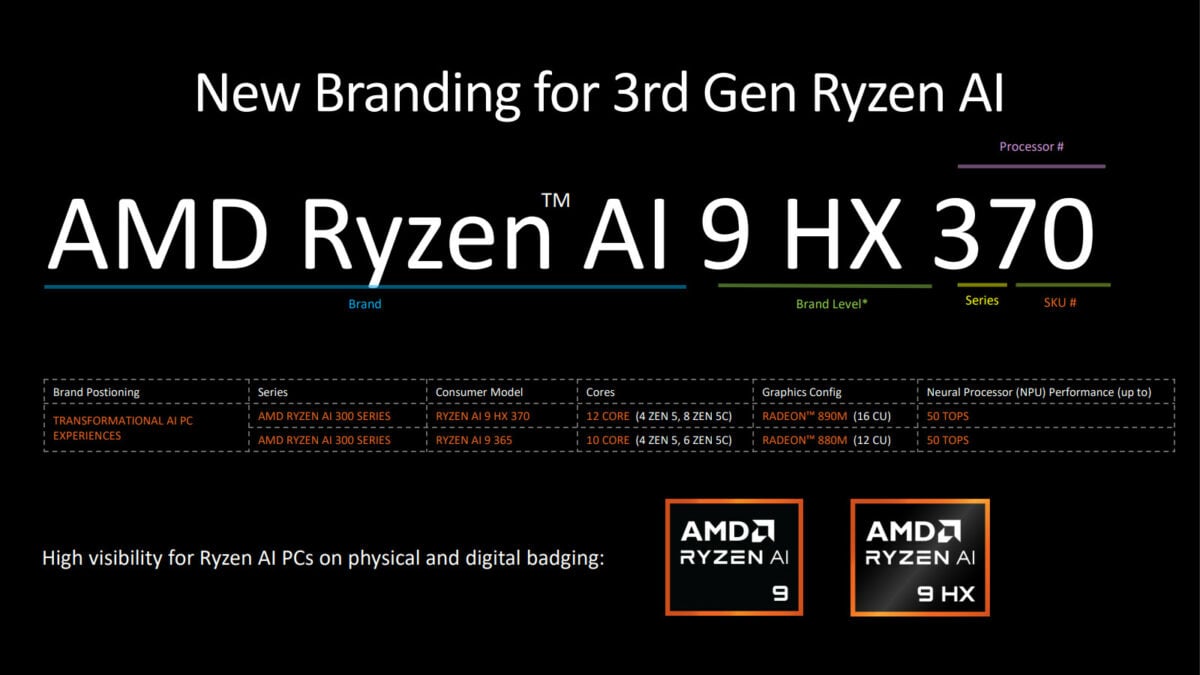
Blink and you might’ve missed it, but AMD is also changing the way it’s branding individual processors on top of the new overarching Ryzen AI 300 series brand. The new ‘HX’ designation, enjoyed by Ryzen AI 9 HX 370, denotes a chip that sits at the top of a stack. As Ryzen AI 9 365 sits below the aforementioned processor, it naturally forgoes the new badging.
While this is all much of a muchness, I am concerned that AMD has made the decision to drop TDP suffixes (U, H, HS) and change what HX means. Instead, it will be up to manufacturers to decide on power limits ranging from 15W to 54W. This appears to leave power-conscious users little choice but to dig through specs sheets to uncover the TDP of their processor, a tedium that laptop graphics has already made me well tired of.
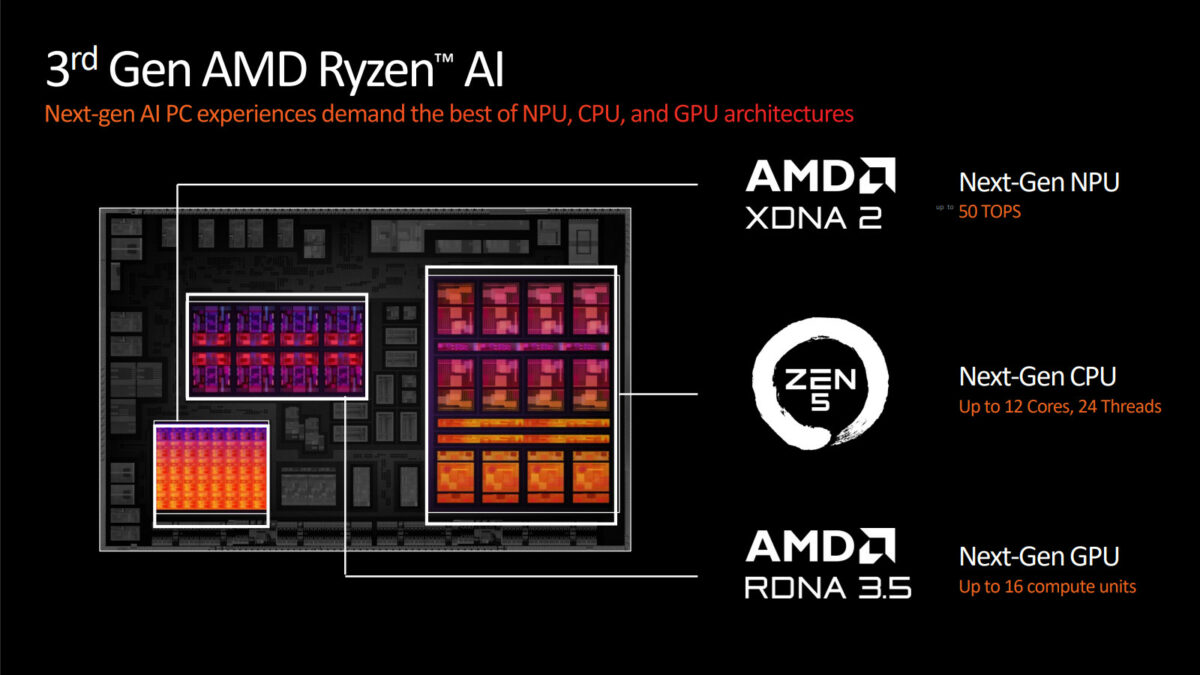
Ryzen AI 300 series specs
With the transition to Ryzen AI 300 series explained, let’s move on to the good stuff. Core counts are up compared to the Ryzen 8040 series, with Ryzen AI 9 HX 370 boasting 12 in total. However, these aren’t all full-fat Zen 5 core as this count includes Zen 5c cores too, specifically four of the former and eight of the latter. Meanwhile, Ryzen AI 9 365 features ten total cores, made up of four Zen 5 cores and eight Zen 5c cores.
For the uninitiated, Zen 5c cores are not to be confused with Efficient-cores as found on Intel processors but are a continuation of the design laid down by their Zen 4c predecessors. Instead, these smaller, more dense cores have less cache and lower clocks at their disposal but are otherwise comparable to Zen 5 cores. As such, each core carries two threads, giving Ryzen AI 9 HX 370 and Ryzen AI 9 365 respective totals of 24 and 20.
| Ryzen AI 9 HX 370 | Ryzen AI 9 365 | |
|---|---|---|
| Cores (Zen 5 + Zen 5c) | 12 (4 + 8) | 10 (4 + 6) |
| Threads | 24 | 20 |
| Maximum boost clock | 5.1GHz | 5.0GHz |
| Total cache | 36MB | 34MB |
| Graphics | Radeon 890M | Radeon 880M |
| Compute units | 16 | 12 |
| NPU | XDNA 2 | XDNA 2 |
| TOPS | 50 | 50 |
| TDP | 15-54W | 15-54W |
The shift to RDNA 3.5 graphics with Ryzen AI 300 series naturally brings new iGPUs too: Radeon 890M and 880M. Outside of their compute units, 16 for 890M and 12 for 880M, little else is known about their technical makeup. However, AMD has provided some benchmarks, which we’ll explore imminently.
Finally, every Ryzen AI 300 series chip comes with an XDNA 2 NPU. This part of the processor sees the largest generational jump, with AMD claiming around 50 TOPS of performance compared to the measly 16 found on Ryzen 8040 series processors. Better still, they pack five-times more compute capacity and are twice as efficient to boot.
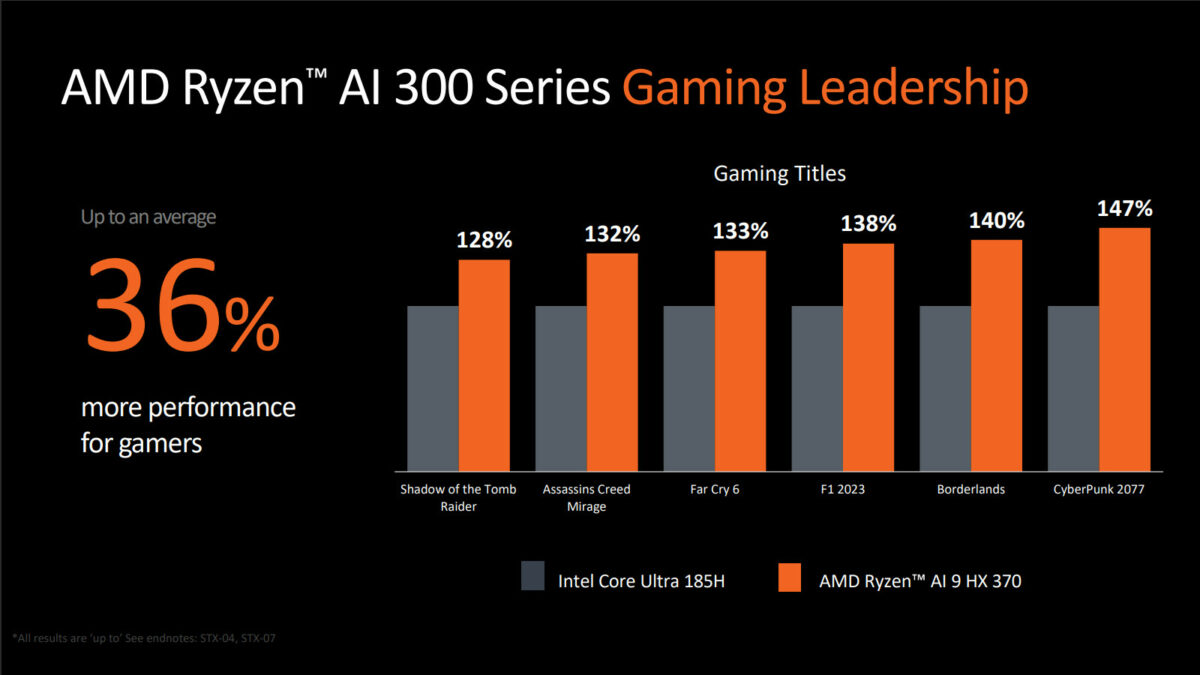
AMD Ryzen AI 300 series benchmarks
As much as the Ryzen AI 300 series promises a massive uplift for anything and everything to do with artificial intelligence, there’s still plenty to sing and dance about in terms of CPU and GPU performance. In fact, based on the numbers here supplied by AMD, I’m far more keen to see these chips powering handheld gaming devices than I am inside a CoPilot+ PC.
Starting with games, then, AMD claims Ryzen AI 9 HX 370 boasts “up to an average 36% more performance” compared to Intel’s Core Ultra 9 185H processor equipped with Arc graphics. While that’s quite a hill to climb, Intel may close the gap with its Lune Lake lineup equipped with next-generation Arc integrated graphics. Sadly, AMD made no comparisons between prior generation Ryzen processors with RDNA 3 iGPUs, but it’s safe to assume the uplift isn’t as large given this is a mid-generation refresh of sorts.
Ryzen AI 300 series processors could be a prime candidate to power Steam Deck 2, given its wide TDP range. Regardless of whether Valve decides to put one in its handheld, though, the likes of Ryzen AI 9 HX 370 are sure to bring plenty of willing alternatives out of the woodwork.
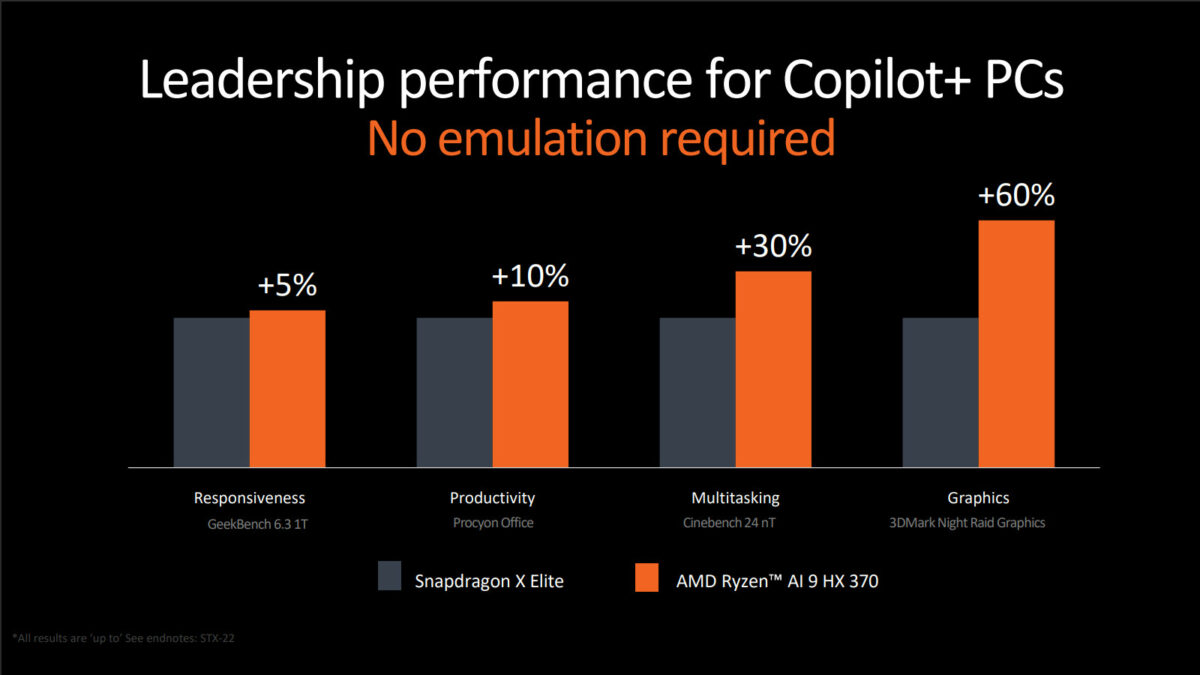
Moving away from x86 and throwing the Ryzen AI 300 series up against the best of ARM, AMD reckons it has the upper hand in terms of CPU performance. Ryzen AI HX 370’s most direct competitor for now is Snapdragon X Elite, rather than Apple M3, as each will feature in Windows laptops. Still, results across a wide range of applications, including Adobe Premiere Pro, Cinebench, paint the Zen 5 chip rather favourably.
The advantages enjoyed by the Ryzen AI 300 series range from mild single-digit wins, bottoming out at 4%, to enormously large leads of 98% at best. However, these benchmarks have of course been curated by AMD to paint its new processors in the best light possible. As such, take everything you see here with a grain of salt.
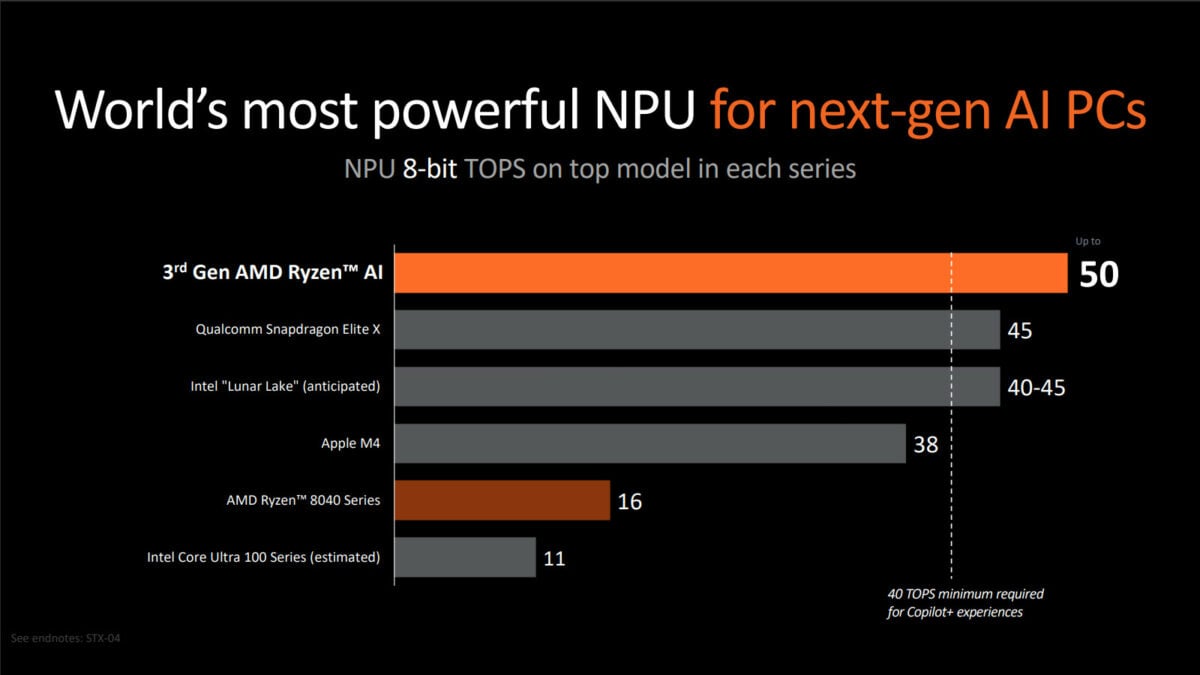
Of course, AMD is most proud of the NPU that’s a part of every Ryzen AI 300 series processor. With 50 TOPS of performance, the company’s stack pulls ahead of the 45 TOPS offered by Snapdragon X Elite (but what’s 5 TOPS between rivals?). It’s also in excess of Microsoft’s 40 TOPS requirement for Copilot+ experiences such as AI Recall.
Turning to more well-established uses of NPUs, though, AMD says Ryzen AI 300 series is up to five-times faster than Core Ultra 9 185H interacting with large language models (LLMs) like Llama v2 7B. Naturally, as every LLM is unique, this accolade will undoubtedly vary. XDNA 2 has one more trick up its sleeve that should pique the interest of those working with large datasets, though: “Block” FP16 NPU. This feature should offer the performance of INT8 with the accuracy of FP16, meaning you no longer have to pick and choose between the two.
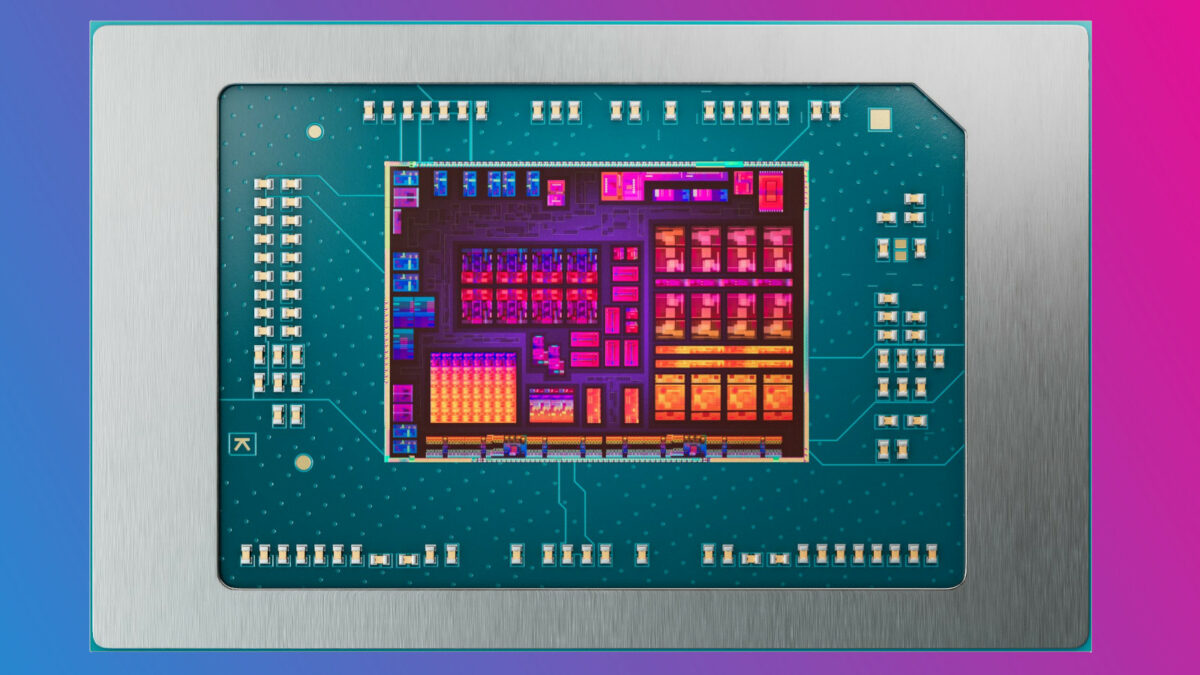
AMD Ryzen AI 300 series analysis
So, it’s clear that there’s more to the Ryzen AI 300 series than its deep learning chops. However, that doesn’t negate the large focus AMD is placing on artificial intelligence with these processors. In the presentation we attended prior their reveal, AMD claimed “AI has the capability to revolutionise how we interact with our PCs,” which is a sentiment I appreciate but am yet to see a compelling example of this in action. Perhaps putting the extra TOPS in these chips will alter my perspective, particularly as new applications arise in the wake of more performance.
Until Intel gets Lunar Lake out the door, AMD is short of any real competition in the x86 arena with the Ryzen AI 300 series. That said, ARM processors like Snapdragon X Elite could see the market take a different direction, or at least see it become more diverse. Putting away the crystal ball for a moment, though, the realities promised by chips like Ryzen AI 9 HX 370 are tantalising. After all, the splendour brought about by improvements to CPU and GPU performance is a tale as old as time (or, I guess, computing).
The first laptops with Ryzen AI 300 series processors will hit the market in July 2024, and I look forward to putting their capabilities and versatility to the test. Naturally, I’ll be keeping my eager eyes out for the first handhelds to sport a Zen 5 cores and RDNA 3.5 graphics too.
For more Computex news, we’ve got all the details on AMD’s new Ryzen 9000 series desktop processors. If graphics cards are more your speed, Team Red has also unveiled a slimmer version of its Radeon Pro W7900 workstation flagship.
